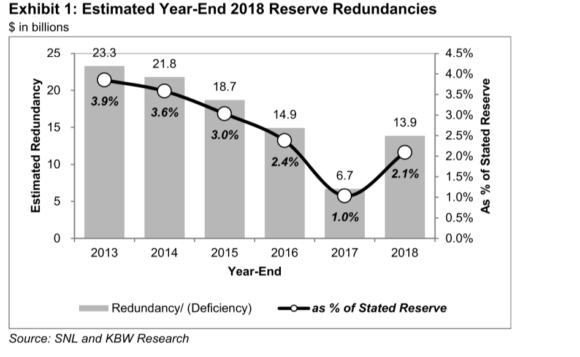Separate reports by financial analysts concluded that property and casualty carriers improved the condition of their claim reserves in 2018, in large part because of favorable loss development in the workers’ compensation line.
Keefe, Bruyette & Woods reported that property casualty carriers had a net $13.9 billion in “reserve redundancies” across all lines at the end of 2018. That included a $14 billion redundancy in workers’ compensation, offset by deficiencies in other liability, commercial auto and products liability.
A.M. Best painted a less rosy picture. It reported that property and casualty reserves were strengthened by $3.6 billion during the year, but were still deficient by $29.3 billion, or 3.8% of reported surplus, at the end of 2018. The ratings house said the reserve deficiency has remained at less than 5% of surplus since 2015.
“In 2017, the industry reported its 12th consecutive calendar year of favorable reserve development,” A.M. Best said in a press release. The full report is available for purchase.
KBW said the year-end reserve redundancy was equal to 2.1% of stated reserves for property and casualty carriers, up from 1% at the end of 2017. KBW said until this year, the reserve redundancy had steadily ticked down, dropping from $23.3 billion in 2013 to $6.7 billion in 2017, before rebounding last year.
“We attribute the industry’s apparently recovering reserve redundancies largely to 2018’s (admittedly modest) rate increases in most lines of business, along with sustained —and hence more credible — favorable workers’ compensation loss development patterns,” the report says.
As reserve redundancies increased, carriers stepped up releases from their reserves. KBW said property and casualty reserve releases amounted to $12.1 billion in 2018, with $7.1 billion of that coming from the workers’ compensation line.
Loss development for the auto physical damage line improved by $2.7 billion in 2018 while special property improved by $1.3 billion. Those improvements were offset by $2.2 billion unfavorable development for other liability and a $1.8 billion unfavorable development in commercial auto liability.
Other liability-occurrence had a $6.5 billion deficiency at year’s end and other liability-claims made had a $4.7 billion deficiency.
“It’s probably a combination of aggressive pricing (insurers generally establish less conservative loss picks during periods of soft insurance pricing) and a more forceful trial bar,” KBW analyst Meyer Shields said in an email.
The strength of reserves was not equal among all carriers. KBW said American International Group and Mercury General Corp. both held less in reserves than investors would expect. He said AIG is modestly over-reserved, while Mercury is underreserred.
On the other hand, KBW said it recommends Arch Capital Group, American Financial Group, Amerisafe, Axis Capital Holdings, Chubb Limited, Hartford Financial Services, ProAssurance Corp. and The Travelers Cos. as “persistently conservative reservers.”
Was this article valuable?
Here are more articles you may enjoy.

 Musk’s xAI Faces California AG Probe Over Grok Sexual Images
Musk’s xAI Faces California AG Probe Over Grok Sexual Images  Munich Re: Insured Losses From Wildfires, Storms and Floods Hit Record High
Munich Re: Insured Losses From Wildfires, Storms and Floods Hit Record High  California Bill Would Require Insurer Claims Handling Plans, And Double Penalties
California Bill Would Require Insurer Claims Handling Plans, And Double Penalties  Musk’s X Probed by UK Over Grok’s Thousands of Sexualized Images
Musk’s X Probed by UK Over Grok’s Thousands of Sexualized Images 